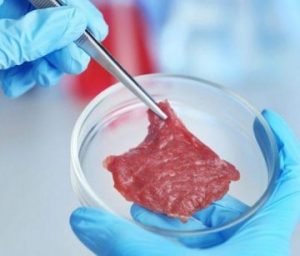THREE ARTICLES
The Times Book Review
Billion Dollar Burger by Chase Purdy review — your dinner’s in the lab
Lab-grown ‘clean meat’ will soon be on our plates. Should we be licking our lips, asks Martha Gill
After all a lab burger, the journalist Chase Purdy argues, is made from the same basic stuff as the real thing: animal muscle cells. With a few tweaks — added fat cells, “scaffolding” to imitate the stringy texture of meat — the taste and feel can be indistinguishable. And there are huge potential benefits. The meat industry slaughters billions of animals every year and causes 14 per cent of greenhouse gas emissions. Cultured meat could mean an end to food poisoning too: the salmonella and E. coli that breed in filthy abattoirs don’t stand a chance in a sterile lab. Then there is the fact that climate change is threatening global food production. Lab-grown meat could make up the difference.

So where’s the problem? Following various “meat technology” start-ups as they beaver away in the lab and race to get their products on plates, Purdy identifies three main obstacles.
One is psychological. Offered some lab-grown pâté, Purdy can only think: “Cells!” It tastes right, though, and he has a second helping. The name is key; the start-ups try different labels, such as “in vitro meat”, “cultured meat”, “cell-based meat”, before eventually settling on “clean meat”, in a bid to appeal to customers. Yet that inflames an existing war with the meat industry, which understandably dislikes the implication its product is dirty. Neither does “clean meat” always translate well. In Dutch, a clean-meat activist says, it implies the food has been run through detergent.
Then there are some of the more enthusiastic “clean meat” activists. One, Koert van Mensvoort, has written a theoretical cookbook that features a recipe for “roast raptor”, “knitted” meat and see-through sashimi. Among the most off-putting recipes is meat you can grow on your own skin. One particularly grim illustration shows whisky-soaked meat cubes, each labelled with a photos of pop icons such as Kanye West and Miley Cyrus. In this scenario the cubes have been grown from their stem cells.
Those creepy concoctions aside, soothing fears will require providing the public with more information. For instance, meat start-ups are secretive about what exactly is in their “vat fluid” in which the growing mass of cells float. This once consisted of serum drawn from foetal cows, which was vastly expensive (and unethical). Now it is plant-based — but without a recipe, customers may be hard to reassure.
Should customers “get past the whole thought of it all”, as Purdy’s sceptical aunt puts it, there is the second big obstacle: price. The first lab-grown burger, produced in 2013, was estimated to have cost $330,000 — 1lb of that beef would be $1.2 billion. But the price is falling fast. In early 2019 an Israel-based company said it had got in vitro beef down to $100 a pound. By 2022, it claims, the price will have dropped to $10 a pound.
A third barrier, Purdy says, is the “difficult regulatory environment” influenced by the traditional meat industry. Meat lobbyists have their own name for the vat-grown product — “fake meat” — and have petitioned to narrow the definition of “meat” to exclude it. Yet history is on the side of the outsiders. Furious lobbying by the butter industry in the late 19th century could not stop the march of margarine (even though it was restricted in 24 US states and in five had to be dyed pink). Egg companies lost their battle to squash eggless mayonnaise. Attempts by the dairy industry to stop plant-based milks using the word “milk” on their packaging have failed.
Purdy spends rather too long on the minutiae of the various regulatory battles, but the rest of the book bounces along, helped by accounts of his encounters with the food tech business. Purdy’s character sketch of Josh Tetrick — lab meat’s own Steve Jobs — is a particular treat. Purdy admires him, but Tetrick’s employees do not always agree. “Lying, manipulative, thin-skinned, attention-seeking, reactionary, incompetent,” was one description of his management style.
Purdy leaves the reader clear about what will happen next. Clean meat is coming; it cannot be stopped because there is “too much money, science and willpower pushing it into the market”. Indeed, some meat companies are switching sides and investing in their diminutive rivals, and rebranding as “protein companies”. In Israel, where limited land and water to grow food are extra incentives, the technology is shooting ahead. One company, Aleph Farms, is growing meat with a vascular system — ready, it claims, in 2023.
That shouldn’t surprise those who have been paying attention. In 1932 Churchill wrote “fifty years hence, we shall escape the absurdity of growing a whole chicken in order to eat the breast or wing by growing these parts separately under a suitable medium”. We may not be far off.
Billion Dollar Burger: Inside Big Tech’s Race for the Future of Food by Chase Purdy, Piatkus, 272pp; £14.99
ARTICLE TWO
Is 2020 the year cell-cultured meat arrives?
WHERE’S THE BEEF?
Chase Purdy’s new book explores the industry that could one day give rise to a kosher cheeseburger

Author Chase Purdy and his new book CAIT KELLY
The concept of cell-cultured meat is simple. Cells — usually muscle — are harvested from an animal and then multiplied in a lab, creating tissue. The end result is meat that is — in taste, texture and preparation — remarkably similar to what can be found in grocery stores around the world, but without the carbon emissions found in traditional animal products.
Purdy, a journalist who had previously covered criminal justice issues, first started writing about food and agriculture in 2014 when he joined Politico as a staff writer. Billion Dollar Burger is the end result of two years of research into the world of cell-cultured meat.
Purdy traveled the globe to research his book, visiting labs and meeting with researchers, religious authorities, chefs and other experts. He made several trips to Israel, which — along with Singapore and the United States — is at the forefront of the industry.
It didn’t surprise Purdy that Israel is one of the countries leading the research into cell-cultured meat. “Israel is one of those countries in the world that has had to be extremely conscientious of its own sort of national security, and food security is part of that,” Purdy said, pointing to the advances Israel has made in water technology. “Think about the desalination plants that are turning seawater into potable water. The world is taking its cues from Israel when it comes to desalination of water, and so I think that it’s not a huge leap to think that the world will take a lot of its cues from Israel when it comes to sustainably producing cell-cultured meat.”
And he thinks cell-cultured meat will soon be having its moment globally. Of course, it first has to clear regulatory hurdles, but Purdy is confident that approval will come — potentially within the year. “Do I think that 2020 could be the year? Totally,” he said. “It really depends on the regulatory agencies, the people who are in charge of overseeing and making sure that food safety… You really need the USDA and the FDA, or their counterparts in another country like Singapore and Israel, to give the official stamp of approval. That’s going to be what really decides this.”
Purdy explained that there are dozens of companies producing cell-cultured meat around the world, and roughly one-third of them are “pretty much ready to be serving small amounts of very, sort of basic new products.” The first places to carry the meat, he predicts, will be restaurants in urban areas like San Francisco and New York. It will take a few more years before grocery stores will start to stock cell-cultured products, he predicted.
The author called the shift to cell-cultured meat an “optimistic and promising tool” to tackle climate change, citing the significant greenhouse gas emissions that come from animal agriculture.
Economic development in large countries like India and China has created larger middle classes and accelerated the demand for meat. That increasing demand, he said, will lead to consumers turning to cheaper, easily available meat products.
“Humans throughout history, whenever they have more money to spend, have traditionally turned to incorporate more meat and dairy into their diet,” he said. “And the truth of the matter is, is that if you look at consumption of meat globally right now, every single analyst will tell you that the demand for meat is only going to go up.”
While the demand is going up, there are some that have taken longer to come on board.
“I remember sitting down with one imam, he was watching one of the videos that described how cell-cultured meat is made,” Purdy said. “And he was just sort of blown away and was like, ‘You’ll need to come back later and talk to me and we can think about this some more.’”
The verdict is still out on whether the meat could be considered halal. But could it be kosher?
Purdy told JI that cell-cultured meat would be considered pareve and could be eaten with either dairy or meat.
Purdy consulted the experts — in this case, Rabbi Menachem Genack, the head of the Orthodox Union’s kosher division. Genack, Purdy writes, was enthusiastic about the possibility of kosher cell-cultured meat, though “he stops short of saying cell-cultured pork could be kosher. He lauds it as an innovation that is especially promising for the environment during a time when climate change has understandably become a source of anxiety.”
He compares Genack’s excitement to “the excitement of the people making cell-cultured meat, for whom religious dietary restrictions could be lucrative,” noting the $24 billion kosher food industry and the $1.6 trillion halal market.
On a trip to Silicon Valley, Purdy ran into an Israeli researcher. “He told me in a conversation that he had been talking with a rabbi, and that the rabbi told him that there’s this sort of line of thought that has sort of existed for hundreds of years, that someday that pig would be OK, that pork would be OK to eat and that would be a major signal for something amazing for the world.”
Purdy opens one chapter, which explores the kashrut of cell-curated meat, with a story about Rabbi Chaim ibn Attar, who traveled from Morocco to Jerusalem in the 18th century, stopping for years in Italy, where he received community funds that enabled him to print his religious commentary. Included in his published writings was the idea that in the future, the physiology of a pig would be altered enough to make it permissible to be eaten by Jews.
When Purdy first heard about the concept, he was intrigued. “I was like, ‘You need to tell me everything you know about this, because what you’re saying is [a] very fun sort of idea to play with that, like, cell-cultured meat could be this signal that the world is going to change.”
And Purdy does believe that cell-cultured meat will change the world. But that wasn’t his end game.
His goal in writing the book, he said, wasn’t to become a cheerleader for the industry, but “to give people some more language so they could actually talk about this and think about it… if our charge in life is to repair the world, I think that you have to be thoughtful about this.”


